
A birch is a thin-leaved deciduous hardwood tree of the genus Betula, in the family Betulaceae, which also includes alders, hazels, and hornbeams. It is closely related to the beech-oak family Fagaceae. The genus Betula contains 30 to 60 known taxa of which 11 are on the IUCN 2011 Red List of Threatened Species. They are typically short-lived pioneer species and are widespread in the Northern Hemisphere, particularly in northern areas of temperate climates and in boreal climates. Birch wood is used for a wide range of purposes.

Betula pendula, commonly known as silver birch, warty birch, European white birch, or East Asian white birch, is a species of tree in the family Betulaceae, native to Europe and parts of Asia, though in southern Europe, it is only found at higher altitudes. Its range extends into Siberia, China, and southwest Asia in the mountains of northern Turkey, the Caucasus, and northern Iran. It has been introduced into North America, where it is known as the European white birch or weeping birch and is considered invasive in some states in the United States and parts of Canada. The tree can also be found in more temperate regions of Australia.
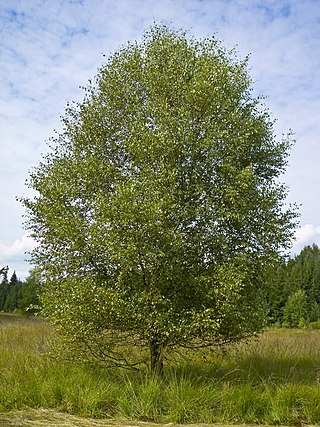
Betula pubescens, commonly known as downy birch and also as moor birch, white birch, European white birch or hairy birch, is a species of deciduous tree, native and abundant throughout northern Europe and northern Asia, growing farther north than any other broadleaf tree. It is closely related to, and often confused with, the silver birch, but grows in wetter places with heavier soils and poorer drainage; smaller trees can also be confused with the dwarf birch.

Betula nigra, the black birch, river birch or water birch, is a species of birch native to the Eastern United States from New Hampshire west to southern Minnesota, and south to northern Florida and west to Texas. It is one of the few heat-tolerant birches in a family of mostly cold-weather trees which do not thrive in USDA Zone 6 and up. B. nigra commonly occurs in floodplains and swamps.

Larix laricina, commonly known as the tamarack, hackmatack, eastern larch, black larch, red larch, or American larch, is a species of larch native to Canada, from eastern Yukon and Inuvik, Northwest Territories east to Newfoundland, and also south into the upper northeastern United States from Minnesota to Cranesville Swamp, West Virginia; there is also an isolated population in central Alaska.

Betula papyrifera is a short-lived species of birch native to northern North America. Paper birch is named after the tree's thin white bark, which often peels in paper-like layers from the trunk. Paper birch is often one of the first species to colonize a burned area within the northern latitudes, and is an important species for moose browsing. Primary commercial uses for paper birch wood are as boltwood and sawlogs, while secondary products include firewood and pulpwood. It is the provincial tree of Saskatchewan and the state tree of New Hampshire.

Betula alleghaniensis, the yellow birch, golden birch, or swamp birch, is a large tree and an important lumber species of birch native to northeastern North America. Its vernacular names refer to the golden color of the tree's bark. In the past its scientific name was Betula lutea, the yellow birch.
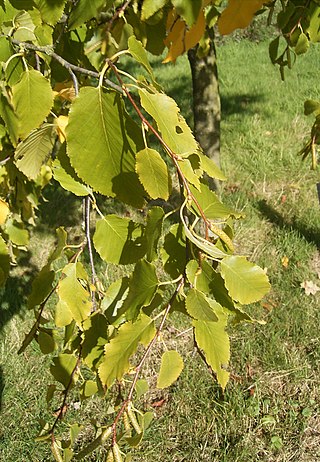
Betula lenta is a species of birch native to eastern North America, from southern Maine west to southernmost Ontario, and south in the Appalachian Mountains to northern Georgia.

Betula nana, the dwarf birch, is a species of birch in the family Betulaceae, found mainly in the tundra of the Arctic region.

Betula neoalaskana or Alaska birch, also known as Alaska paper birch or resin birch, is a species of birch native to Alaska and northern Canada. Its range covers most of interior Alaska, and extends from the southern Brooks Range to the Chugach Range in Alaska, including the Turnagain Arm and northern half of the Kenai Peninsula, eastward from Norton Sound through the Yukon, Northwest Territories, British Columbia, Alberta, Saskatchewan, Manitoba, southern Nunavut, and into northwestern Ontario.
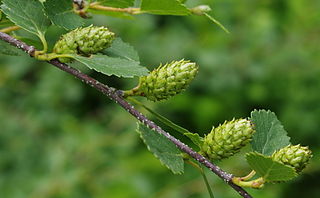
Betula glandulosa, the American dwarf birch, also known as resin birch or shrub birch, is a species of birch native to North America.
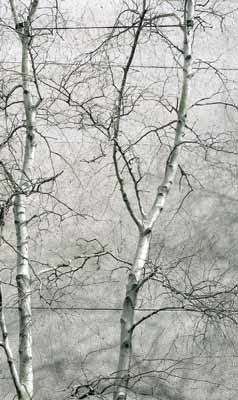
Betula populifolia, known as the gray birch, is a deciduous tree in the family Betulaceae. It is native to eastern North America and is most commonly found in the northeast United States as well as southern Quebec, New Brunswick, and Nova Scotia. The tree is a pioneer species that is commonly found in sites following disturbance, such as fire or logging. Gray birches don't have as much economic value as other birch species but are still commonly used as ornamental trees.

Betula occidentalis, the water birch or red birch, is a species of birch native to western North America, in Canada from Yukon east to Northwestern Ontario and southwards, and in the United States from eastern Washington east to western North Dakota, and south to eastern California, northern Arizona and northern New Mexico, and southwestern Alaska. It typically occurs along streams in mountainous regions, sometimes at elevations of 2,100 metres and in drier areas than paper birch.
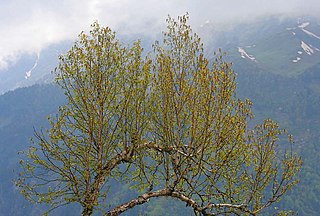
Betula utilis, the Himalayan birch, is a deciduous tree native to the Western Himalayas, growing at elevations up to 4,500 m (14,800 ft). The Latin specific epithet utilis means "useful", and refers to the many uses of the different parts of the tree. The white, paper-like bark was used in ancient times as a writing surface for manuscripts of Sanskrit literature. It is still used as paper for the writing of mantras, with the bark placed in an amulet and worn for protection. Selected varieties are used for landscaping throughout the world, even while some areas of its native habitat are being lost due to overuse of the tree for firewood.

Salix arbusculoides is a species of flowering plant in the willow family known by the common name little tree willow. It is native to northern North America, where its distribution extends across Alaska and most of Canada.

Betula albosinensis, commonly known as the Chinese red birch, is a species of birch in the family Betulaceae, native to Western China. It is notable for its distinctive peeling bark and is cultivated as an ornamental tree.

Betula grossa, commonly known as Japanese cherry birch, is a species of birch native to Japan, where it grows naturally in mixed woodland on hill and mountain slopes in Honshu, Shikoku, and Kyushu. It was introduced to the West in 1896, but remains rare in cultivation.

Betula chichibuensis, commonly known as Chichibu birch, is a species of birch native exclusively to limestone outcrops in the Okuchichibu and Kitakami Mountains of central and northeast Honshu, Japan. The tree is rated as Critically Endangered on the IUCN Red List due to its extreme rarity and limited range.
Betula murrayana commonly known as Murray birch, is a critically endangered species of small birch that is endemic to Washtenaw County, Michigan in the United States and St. Williams, Norfolk County, Ontario, in Canada.



















